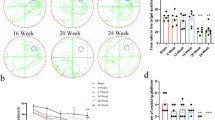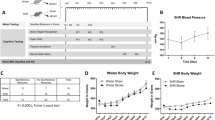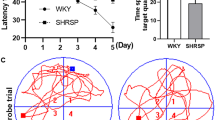Abstract
Hypertension is considered one of the most important controllable risk factors for white matter lesion (WML). Our previous work found that stroke-prone renovascular hypertensive rats (RHRSP) displayed a high rate of WML. This study aimed to investigate the WML in RHRSP from MRI, pathology and behavior. RHRSP model was established by two-kidney, two-clipmethod and kept for 20 weeks. WML was decteted by magnetic resonance imaging (MRI) and loyez staining. Cognition was tested by morris water maze (MWM). Vascular changes were observed by HE staining on brain and carotid sections. Ultrastucture of blood brain barrier (BBB) were observed by transmission electron microscope. Immunofluorescence was used to detect albumin leakage and cell proliferation. T2-weighted MRI scans of RHRSP displayed diffuse, confluent white-matter hyperintensities. Pathological examination of the same rat showed marked vacuoles, disappearence of myelin and nerve fibers in white matter, supporting the neuroimaging findings. Spatial learning and memory impairment were observed in RHRSP. The small arteries in brain exhibited fibrinoid necrosis, hyalinosis and vascular remodeling. BBB disruption and plasma albumin leakage into vascular wall was observed in RHRSP. Increased cell proliferation in subventricular zone was seen in RHRSP. RHRSP demonstrated spontaneous WML and cognitive impairment. Hypertensive small vessel lesions and BBB disruption might paly causative factors for the onset and development of WML. The characteristic features of WML in RHRSP suggested it a valid animal model for WML.







Similar content being viewed by others
References
Bailey EL, Smith C, Sudlow CL et al (2011) Is the spontaneously hypertensive stroke prone rat a pertinent model of sub cortical ischemic stroke? A systematic review. Int J Stroke 6(5):434–444
Breteler MM, van Amerongen NM, van Swieten JC et al (1994) Cognitive correlates of ventricular enlargement and cerebral white matter lesions on magnetic resonance imaging. The Rotterdam Study. Stroke 25(6):1109–1115
Briley DP, Wasay M, Sergent S et al (1997) Cerebral white matter changes (leukoaraiosis), stroke, and gait disturbance. J Am Geriatr Soc 45(12):1434–1438
Brittain JF, McCabe C, Khatun H et al (2013) An MRI-histological study of white matter in stroke-free SHRSP. J Cereb Blood Flow Metab 33(5):760–763
de Leeuw FE, de Groot JC, Oudkerk M et al (2002) Hypertension and cerebral white matter lesions in a prospective cohort study. Brain 125(Pt 4):765–772
Grueter BE, Schulz UG (2012) Age-related cerebral white matter disease (leukoaraiosis): a review. Postgrad Med J 88(1036):79–87
Hainsworth AH, Markus HS (2008) Do in vivo experimental models reflect human cerebral small vessel disease? A systematic review. J Cereb Blood Flow Metab 28(12):1877–1891
Holland PR, Pannozzo MA, Bastin ME et al (2015) Hypertension fails to disrupt white matter integrity in young or aged Fisher (F44) Cyp1a1Ren2 transgenic rats. J Cereb Blood Flow Metab 35(2):188–192
Huang YH, Zhang WW, Lin L et al (2010) Could changes in arterioles impede the perivascular drainage of interstitial fluid from the cerebral white matter in leukoaraiosis? Neuropathol Appl Neurobiol 36(3):237–247
Jalal FY, Yang Y, Thompson JF et al (2015) Hypoxia-induced neuroinflammatory white-matter injury reduced by minocycline in SHR/SP. J Cereb Blood Flow Metab 35(7):1145–115324
Lan LF, Zheng L, Yang X et al (2015) Peroxisome proliferator-activated receptor-γ agonist pioglitazone ameliorates white matter lesion and cognitive impairment in hypertensive rats. CNS Neurosci Ther 21(5):410–416
Launer LJ (2004) Epidemiology of white matter lesions. Top Magn Reson Imaging 15(6):365–367
Lin JX, Tomimoto H, Akiguchi I et al (2001) White matter lesions and alteration of vascular cell composition in the brain of spontaneously hypertensive rats. Neuroreport 12(9):1835–1839
Murray AD, Staff RT, McNeil CJ et al (2012) Brain lesions, hypertension and cognitive ageing in the 1921 and 1936 Aberdeen birth cohorts. Age (Dordr) 34(2):451–459
Nabika T, Cui Z, Masuda J (2004) The stroke-prone spontaneously hypertensive rat: how good is it as a model for cerebrovascular diseases? Cell Mol Neurobiol 24(5):639–646
O’Sullivan M (2008) Leukoaraiosis. Pract Neurol 8(1):26–382
Pantoni L, Poggesi A, Basile AM et al (2006) Leukoaraiosis predicts hidden global functioning impairment in nondisabled older people: the LADIS (leukoaraiosis and disability in the elderly) study. J Am Geriatr Soc 54(7):1095–1101
Poels MM, Steyerberg EW, Wieberdink RG et al (2012) Assessment of cerebral small vessel disease predicts individual stroke risk. J Neurol Neurosurg Psychiatry 83(12):1174–1179
Prayer D, Prayer L (2003) Diffusion-weighted magnetic resonance imaging of cerebral white matter development. Eur J Radiol 45(3):235–243
Shibata M, Ohtani R, Ihara M et al (2004) White matter lesions and glial activation in a novel mouse model of chronic cerebral hypoperfusion. Stroke 35(11):2598–2603
Simpson JE, Ince PG, Higham CE et al (2007) Microglial activation in white matter lesions and nonlesional white matter of ageing brains. Neuropathol Appl Neurobiol 33(6):670–683
Ueno Y, Zhang N, Miyamoto N et al (2009) Edaravone attenuates white matter lesions through endothelial protection in a rat chronic hypoperfusion model. Neuroscience 162(2):317–327
van Dijk EJ, Breteler MM, Schmidt R et al (2004) The association between blood pressure, hypertension, and cerebral white matter lesions: cardiovascular determinants of dementia study. Hypertension 44(5):625–630
Wakita H, Tomimoto H, Akiguchi I et al (1994) Glial activation and white matter changes in the rat brain induced by chronic cerebral hypoperfusion: an immunohistochemical study. Acta Neuropathol 87(5):484–492
Wardlaw JM, Smith C, Dichgans M (2013) Mechanisms of sporadic cerebral small vessel disease: insights from neuroimaging. Lancet Neurol 12(5):483–497
Zeng J, Zhang Y, Mo J et al (1998) Two-kidney, two clip renovascular hypertensive rats can be used as stroke-prone rats. Stroke 29(8):1708–1713, 1713–1714
Financial support
Natural Science Foundation of Guangdong Province (No. S2013010015840) and the hospital funding “support plan for young talents in the First affiliated Hospital of Sun Yat-sen University”.
Author information
Authors and Affiliations
Corresponding authors
Additional information
Yuhua Fan and Linfang Lan contributed equally to this work.
Rights and permissions
About this article
Cite this article
Fan, Y., Lan, L., Zheng, L. et al. Spontaneous white matter lesion in brain of stroke-prone renovascular hypertensive rats: a study from MRI, pathology and behavior. Metab Brain Dis 30, 1479–1486 (2015). https://doi.org/10.1007/s11011-015-9722-9
Received:
Accepted:
Published:
Issue Date:
DOI: https://doi.org/10.1007/s11011-015-9722-9




